May 2022
- English
- 日本語
Lacquer Coating Technology for Industrial Goods
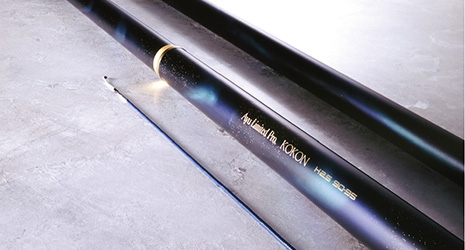
Lacquered fishing rods 
CD player with lacquered surfaces
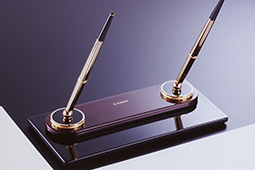
One of the pen stands with lacquered pedestal commissioned by Parker Pen for the White House to commemorate President Reagan’s inauguration 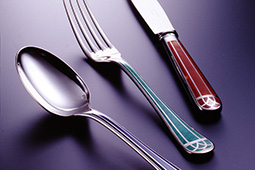
Cutlery with lacquered handles 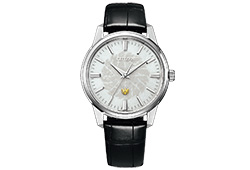
A watch with a washi paper and maki-e (platinum foil and powder) face 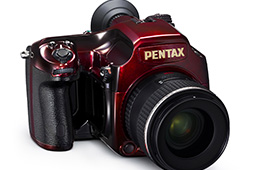
A DSLR camera with lacquered body and logo 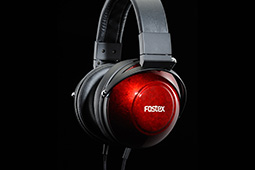
Headphones with lacquered housing 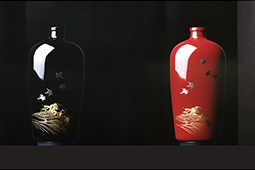
Lacquered bottles of whisky
Products featured are examples related to the article and not endorsements.

A company in Aizuwakamatsu City, Fukushima Prefecture, has developed a technology to coat various goods such as cameras, watches and automobile parts with lacquer, expanding the range of ways the material can be used.

Lacquer has traditionally been used for wooden craft products such as tableware and furniture, typically being applied to unpainted wood, or kiji. However, Urushi Sakamoto Co., Ltd. in Aizuwakamatsu City, Fukushima Prefecture, has explored the development of new technologies in order to expand lacquer’s application to industrial goods made from various materials.
A type of lacquerware known as “Aizu-nuri” has been made in Aizuwakamatsu for more than 400 years. Urushi Sakamoto was founded in 1900 as a company that produced the lacquer used for Aizu-nuri. Sakamoto Asao, who became the third-generation president in 1978, made it the company’s mission to develop unique technologies that matched the needs of the times.

Sakamoto explains, “When I became president, Japan was in a period of high economic growth, with the traditional lacquerware industry already having entered a period of stagnation due to the mass factory production of daily necessities using plastics and the like. I decided to jump on this industrialization trend as a way to utilize lacquer since it is an excellent natural paint with extremely high durability, water resistance, heat insulation, and antiseptic properties, while also being pleasing to the eye.”

The company started developing technologies for applying lacquer to industrial goods, such as for use as a rust inhibitor on ship hulls, as a reinforcement agent for building materials, or to improve speaker sound quality. In 1982, the Parker Pen Company placed an order with the company for 2,000 pen stands to gift the White House in commemoration of the inauguration of US President Ronald Reagan. Sakamoto fulfilled the order by commissioning first-class local craftsmen and delivered the hand-lacquered pen stands as requested, but was surprised when they were all returned due to the coating being “uneven in color and of varying quality.” Sakamoto then understood that a product won’t be accepted as an industrial good unless it has a uniform finish. He solved the problem with the pen stands by developing a unique technique of uniformly applying lacquer using a sprayer, and when after a year they were sent for a second time, all the items were accepted and praised as “beautiful.” Through this experience, Sakamoto made up his mind that “The merits of traditional crafts and the way industrial goods are assessed are different things, so I have to pioneer the industrial field on my own.”

Sakamoto’s pen stands earned the company a reputation among manufacturers in Europe and North America, and since then, the company has received orders from many famous overseas companies and provided its lacquer painting technology to them.

Orders have poured in from Japanese and foreign manufacturers of such goods as cameras, watches, audio and home appliances, cars, and airplanes. The company’s lacquer-coating technology has been used for instrument panels for luxury cars, first-class cabin furnishings for airplanes and even carbon fishing rods. The technology has earned the company high praise and numerous awards, starting with the 1st Monodzukuri (manufacturing) Nippon Grand Award from the Japanese Government’s Ministry of Economy, Trade and Industry in 2005.

Sakamoto explains, “What we have always kept in mind is the need not to cling to tradition, but to make use of tradition in the present day.”
Urushi Sakamoto’s lacquer-painting technology is now being used in the fashion industry, adding lacquer’s luster to pendants and handbags, for example. Focusing on the appeal of lacquer as a natural material, the company continues to explore lacquer’s potential.

Products featured are examples related to the article and not endorsements.

